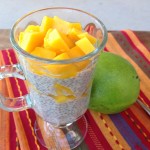 How often do you enjoy the delightful taste and nutrition of a ripe, sweet mango? Does it typically take a backseat to other more familiar fruits? Do you choose frozen mango because you aren’t sure the best way to deal with those pesky pits in the fresh variety?
How often do you enjoy the delightful taste and nutrition of a ripe, sweet mango? Does it typically take a backseat to other more familiar fruits? Do you choose frozen mango because you aren’t sure the best way to deal with those pesky pits in the fresh variety?
Known as the most popular fruit in the world and available year round, the mango is our...
March Superfood of the Month!
Many people love the taste of mango, but are often slightly intimidated...how do you pick a mango? How do you cut a mango? What can you do with it besides eating it raw?
If this is you or someone you know, we hope this will provide some helpful mango tips!
Where do mangos come from?
 Mangos were first grown in India 5,000 years ago. In India, the mango is the symbol of love…a basket of mangos is considered a gesture of friendship. India is the largest producer, but exports very little because they are mostly consumed in-country…they are also very common in Indian cuisine. A mango tree can grow up to 100 feet tall and can produce fruit for over 300 years. Mangos are the national fruit of India, Pakistan and the Philippines and, believe it or not, they are part of the same plant family as cashews and pistachios! Mangos sold in the U.S. are typically imported from Guatemala, Haiti, Ecuador, Brazil, Peru, or Mexico. These countries have crops at different times of the year, which allows us to enjoy mangos year round. Because mangos need tropical climates to grow, local U.S. fruits are typically only produced in Florida, California, Hawaii and Puerto Rico.
Mangos were first grown in India 5,000 years ago. In India, the mango is the symbol of love…a basket of mangos is considered a gesture of friendship. India is the largest producer, but exports very little because they are mostly consumed in-country…they are also very common in Indian cuisine. A mango tree can grow up to 100 feet tall and can produce fruit for over 300 years. Mangos are the national fruit of India, Pakistan and the Philippines and, believe it or not, they are part of the same plant family as cashews and pistachios! Mangos sold in the U.S. are typically imported from Guatemala, Haiti, Ecuador, Brazil, Peru, or Mexico. These countries have crops at different times of the year, which allows us to enjoy mangos year round. Because mangos need tropical climates to grow, local U.S. fruits are typically only produced in Florida, California, Hawaii and Puerto Rico.
Why mangos?
Mangos are a fantastic superfood, providing over 20 different vitamins and minerals! One cup of mango contains about 100 calories and provides 100% of our daily vitamin C. It is also a great source of vitamin A (including beta-carotene) and fiber. The antioxidants found in mangos help fight cancer and the fruit also helps regulate diabetes, aids digestion and contributes to healthy skin. They are also a great source of potassium, which helps control our heart rate and blood pressure. That is one powerful fruit…plus they are delicious! There can be anywhere from one to two cups of edible fruit in one mango which, of course, depends on its size.
How do you pick a mango?
 Don't judge a mango by its color -- red does not necessarily mean ripe! Always judge by feel and aroma…not color. A ripe mango will "give" slightly when you gently squeeze it and will also have a sweet smell. A firm mango will ripen at room temperature within a few days. To speed up the ripening process, you can place a mango in a paper bag at room temperature. Once ripe, you can place the mango in the refrigerator to slow down the ripening process.
Don't judge a mango by its color -- red does not necessarily mean ripe! Always judge by feel and aroma…not color. A ripe mango will "give" slightly when you gently squeeze it and will also have a sweet smell. A firm mango will ripen at room temperature within a few days. To speed up the ripening process, you can place a mango in a paper bag at room temperature. Once ripe, you can place the mango in the refrigerator to slow down the ripening process.
The most common question...
How do you cut a mango and deal with that pesky slippery pit? Below are tips on how to cut a mango or watch our video where Zonya explains this in action!
- Cut around the pit: if you made an imaginary center line down the middle of the mango, you want to place a knife 1/4" over from the center line and cut through the mango. Repeat for the other side. You will be cutting around the center seed of the mango. The ovals of mango flesh are known as the "cheeks" and the inside in the middle is the "seed" or “pit.”
 Cut the mango flesh: holding one mango oval at a time in the palm of your hand, cut parallel slices into the mango flesh, being careful to not cut all the way through the skin. Turn the mango and cut again so you have a checkerboard pattern.
Cut the mango flesh: holding one mango oval at a time in the palm of your hand, cut parallel slices into the mango flesh, being careful to not cut all the way through the skin. Turn the mango and cut again so you have a checkerboard pattern.- Choose your method: Slice and scoop method - scoop mango pieces out of the skin with a large spoon OR Inside out method - turn mango cheek inside out by pushing the skin up from underneath (it will look like a porcupine) and scrape the mango pieces off with a knife or spoon.
Keep in mind: mangos can be eaten with the skin on, but some find the skin to be bitter. The skin is safe to eat as long as you don't have a strong sensitivity to urushiol, which is the active chemical in poison ivy, poison sumac and poison oak. If you have a strong sensitivity, the skin can sometimes cause a contact dermatitis.
Cooking with mangos -- what can you do with mango?
There are some truly amazing ways to use mangos. Just a few ideas include:
- Mango Salsa! Excellent with fish, chicken, pork, and tacos...but is delicious eaten by itself! Check out the mango salsa in the Salmon Taco Lettuce Wraps!
- Smoothies! Add to your favorite smoothie…remember you can use our no-fail smoothie formula, but don't feel like you have to have a recipe. We love the Mango Mint Green Smoothie!
 Savory meals such as Asian Salmon Cakes, Jalapeno Mango Chicken Stir-Fry, and Mango and Black Bean Stuffed Sweet Potato, just to name a few!
Savory meals such as Asian Salmon Cakes, Jalapeno Mango Chicken Stir-Fry, and Mango and Black Bean Stuffed Sweet Potato, just to name a few!- Homemade pudding! Try mango in the Mango Chia Seed Pudding.
- The Chia Coconut Mango Granola is deliciously addicting and contains dried mango!
- Try marinating with mango -- they have a natural tenderizing property which makes them perfect for marinades!
Please join us for our Superfood Challenge for March!
 Here's the challenge...serve mango at least one day a week for the entire month in ALL kinds of different ways.
Here's the challenge...serve mango at least one day a week for the entire month in ALL kinds of different ways.
Get your whole family involved and vote...is it a "keeper" or "sleeper?" From adding to salads, smoothies and various meals, we are confident you will find some great, new mango recipes to incorporate into your routine!



Leave A Comment